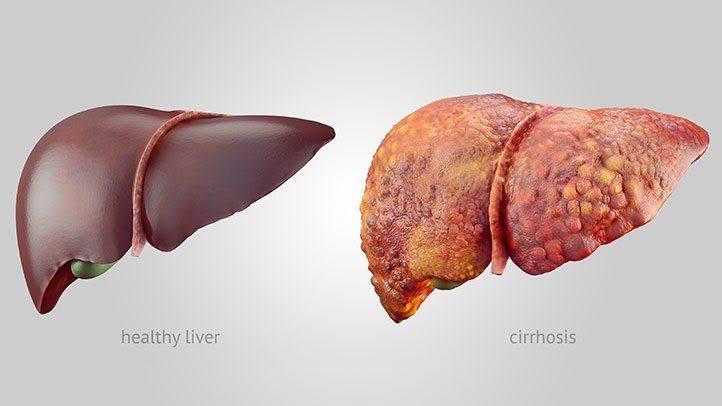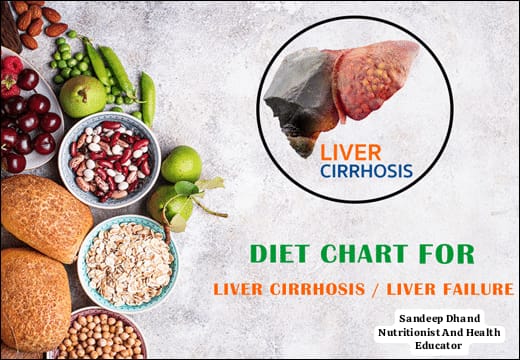Sandeep Dhand
Nutritionist And Health Educator
Liver cirrhosis is a chronic condition in which the liver is damaged and scarred due to long-term injury. This damage makes it difficult for the liver to function properly. The liver is one of the most important organs in our body. It processes nutrients, filters toxins, and produces substances necessary for blood clotting. When cirrhosis occurs, scar tissue replaces healthy liver tissue, which affects its ability to perform these essential tasks.
How Does Liver Cirrhosis Happen?
Cirrhosis doesn’t happen overnight. It develops gradually over time due to repeated damage to the liver. The liver tries to repair itself, but this process leads to scarring. Over time, the scar tissue builds up and disrupts blood flow, making it harder for the liver to work efficiently.
Common Causes of Liver Cirrhosis

- Alcohol Consumption: Drinking too much alcohol over a long period is one of the leading causes of cirrhosis. The liver breaks down alcohol, but excessive amounts can harm liver cells.
- Hepatitis B and C Infections: These viral infections can cause chronic inflammation, which damages the liver over time.
- Non-Alcoholic Fatty Liver Disease (NAFLD): This occurs when fat builds up in the liver. It is often linked to obesity, diabetes, and high cholesterol.
- Autoimmune Hepatitis: The body’s immune system mistakenly attacks liver cells, causing inflammation and damage.
- Genetic Disorders: Conditions like hemochromatosis (too much iron) or Wilson’s disease (too much copper) can lead to cirrhosis.
- Bile Duct Problems: Blocked or damaged bile ducts can lead to bile buildup, damaging liver cells.
- Toxins and Medications: Long-term exposure to certain toxins or drugs can harm the liver.
Symptoms of Liver Cirrhosis
In the early stages, liver cirrhosis might not show noticeable symptoms. However, as the condition worsens, symptoms may include:
Fatigue: Feeling extremely tired or weak.
Loss of Appetite: Reduced interest in eating.
Nausea: Feeling sick to the stomach.
Weight Loss: Losing weight without trying.
Swelling: Fluid buildup in the legs (edema) or abdomen (ascites).
Jaundice: Yellowing of the skin and eyes due to excess bilirubin.
Bruising or Bleeding Easily: The liver makes clotting factors; damage can lead to bleeding issues.
Confusion or Memory Problems: Known as hepatic encephalopathy, caused by toxins building up in the brain.
Spider Veins: Tiny blood vessels visible on the skin.
Complications of Cirrhosis
As cirrhosis progresses, it can lead to severe complications:
- Portal Hypertension: Increased pressure in the veins of the liver, which can lead to swollen veins (varices) in the esophagus or stomach that may burst and cause life-threatening bleeding.
- Liver Cancer: Cirrhosis increases the risk of developing liver cancer.
- Kidney Failure: The liver and kidneys are closely connected, so liver damage can sometimes affect kidney function.
- Infections: People with cirrhosis are more prone to infections, as the immune system becomes weaker.
- Malnutrition: Poor liver function affects nutrient absorption and metabolism.
Nutrition and Liver Cirrhosis
Nutrition plays a vital role in managing liver cirrhosis. A healthy diet can help support liver function, prevent complications, and improve overall well-being.
Nutritional Goals for Cirrhosis Patients
- Prevent Malnutrition: Ensure the body gets enough calories and nutrients.
- Reduce Toxin Buildup: Avoid foods that strain the liver.
- Minimize Fluid Retention: Manage salt and fluid intake.
Dietary Guidelines for Liver Cirrhosis

- Protein
Why It’s Important: Protein helps repair damaged liver cells and maintain muscle mass.
Best Sources: Lean meats (chicken, turkey), fish, eggs, tofu, and legumes.
Caution: In advanced cases with hepatic encephalopathy, protein intake may need monitoring.
- Carbohydrates
Why It’s Important: Carbs are a good energy source, especially when the liver struggles to store glycogen.
Best Sources: Whole grains (brown rice, oats), fruits, and vegetables.
- Fats
Why It’s Important: Healthy fats provide energy and support cell repair.
Best Sources: Avocado, nuts, seeds, and olive oil.
Caution: Limit saturated and trans fats to reduce strain on the liver.
- Salt (Sodium)
Why It’s Important: High salt can worsen fluid retention and swelling.
Limit Intake: Avoid processed foods, canned soups, and salty snacks.
- Fluids
Why It’s Important: Managing fluid intake is crucial for those with ascites.
Guideline: Consult a doctor about fluid restrictions if necessary.
- Vitamins and Minerals
Essential Micronutrients: Cirrhosis can lead to deficiencies in vitamins A, D, E, K, and minerals like zinc.
Sources: Fresh fruits, vegetables, fortified cereals, or supplements (only as prescribed).
- Alcohol
Avoid Completely: Even small amounts can worsen liver damage.
Foods to Include
- High-Calorie Foods: To prevent weight loss, include calorie-dense foods like nuts, seeds, and healthy oils.
- Fiber-Rich Foods: Help digestion and prevent constipation (whole grains, fruits, vegetables).
- Low-Fat Dairy: Provides calcium and protein without too much fat.
- Herbs and Spices: Use them instead of salt to flavor food.
Foods to Avoid
- Alcohol: Even a small amount can harm the liver.
- Fried and Fatty Foods: They are harder for the liver to process.
- Processed Foods: Contain high salt and artificial additives.
- Raw or Undercooked Foods: Reduce the risk of infection (raw seafood, eggs, or meat).
- Sugary Snacks and Beverages: Can contribute to fatty liver.
Lifestyle Tips
- Stay Active: Regular light exercise helps maintain muscle mass and improves overall health.
- Quit Smoking: Smoking can worsen liver damage.
- Vaccination: Protect against hepatitis A and B to prevent further liver complications.
- Regular Check-ups: Monitor liver function and overall health.
Can Liver Cirrhosis Be Reversed?
In its early stages, liver damage can sometimes be slowed or even reversed if the underlying cause is addressed. For example:
Stop Drinking Alcohol: The liver can recover significantly if alcohol is avoided.
Treat Hepatitis: Antiviral medications can control hepatitis B or C infections.
Weight Loss: For NAFLD, losing weight can reduce fat buildup in the liver.
However, in advanced stages, cirrhosis is irreversible. At this point, the focus is on managing symptoms, preventing complications, and maintaining quality of life. In severe cases, a liver transplant may be the only option.
Conclusion
Liver cirrhosis is a serious condition that requires careful management. Understanding its causes, symptoms, and dietary needs can help patients live healthier lives despite the condition. Early diagnosis and lifestyle changes are critical in preventing progression. With the right medical care and nutrition, many people with cirrhosis can still lead fulfilling lives.
